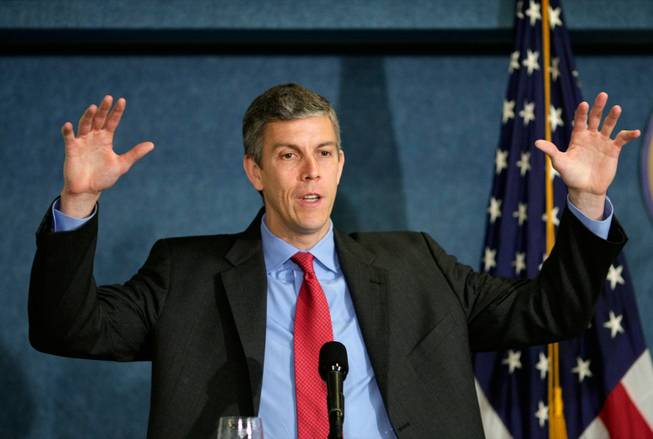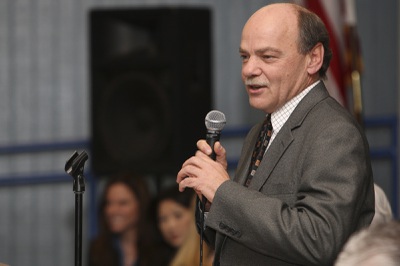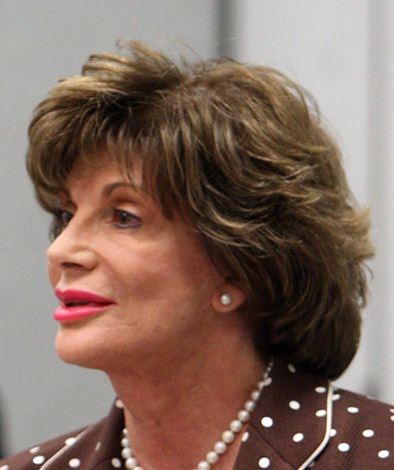
AP Photo/J. Scott Applewhite
Education Secretary Arne Duncan talks about education reform during a speech at the National Press Club in Washington on May 29. Duncan plans to give $4.35 billion to states that use the most innovation in the first round of stimulus spending, and officials here are concerned that Nevada will miss out because of its conservative spending.
Monday, June 22, 2009 | 2 a.m.
Sun Coverage
Sun Archives
- Rainy-day fund's defeat a bitter pill for education (6-3-2009)
- Titus offers schools help cashing in on stimulus (6-1-2009)
- Ready for the coming cuts (5-6-2009)
- Stimulus money isn't coming easy (4-13-2009)
- The stimulus chase (4-8-2009)
- Action on cuts waiting until lawmakers say how much (4-6-2009)
- Budget woes raise issues of cost, value of research (4-5-2009)
- Education funding debated at town hall meeting in Henderson (4-4-2009)
- Declining property tax revenue snags School District budget (4-3-2009)
- Higher education system outlines 'doomsday' budget effects (3-25-2009)
- School district: If you must cut the budget, do it our way (3-23-2009)
- Students, decrying budget cuts, rally for after-school programs (3-16-2009)
- Chancellor Rogers enlists campus help in budget plea (3-12-2009)
- Budget might put teachers in game of musical chairs (3-1-2009)
- Fewer students, but same funding (2-24-2009)
Beyond the Sun
The intent of the federal stimulus money for the nation’s public schools was to foster improvement, innovation and reform. But in Nevada, the funding instead is largely being used to backfill the state’s financial holes.
The idea that the stimulus money might actually stimulate education reform “is something of a fallacy,” says Keith Rheault, Nevada’s superintendent of public instruction. “We’re going to end up looking bad because we won’t be able to do even one new innovative thing with the funding. We’re using it to barely maintain what we had before.”
Of the $394 million Nevada is receiving in so-called “state stabilization funds” from the federal stimulus package, $324 million must be spent on education. Nevada is also receiving $140 million to be shared by special education services and schools serving the poorest neighborhoods.
Although state lawmakers increased basic support to schools by $38 per student — bringing the statewide average to $5,251 for the upcoming fiscal year — local districts will actually see a slight drop in funding over the biennium because of lower-than-expected local property and vehicle registration taxes.
The real difference over the next two years will be that a greater share of the state’s higher education funding will come from Washington, rather than from locally generated taxes. That in turn will mean the state will likely have enough money to meet the K-12 budget obligations.
And although local districts are grateful for the federal help in staunching the bleeding, there is also frustration that the dollars are needed to keep basic services in place, rather than to revive popular programs killed during the early-round budget cuts or to launch new initiatives.
Even if it turns out there is more money than before, the state’s school districts — including Clark County’s — are reluctant to use it to launch any new initiatives or programs because the funding will disappear in two years. That would mean firing staff and ending services that students and families had come to depend on, said Clark County Schools Superintendent Walt Rulffes.
The situation is hardly unique to Nevada. The Council of Great City Schools, a coalition of the nation’s largest urban districts, says dozens of cash-strapped states face similar dilemmas.
The feds recognize the quandary. Education Department officials have advised local districts to avoid “the cliff,” or creating new programs that depend entirely on the short-term stimulus money and could be forced over the precipice after two years.
But the cautious reluctance to use that money for innovations could hurt Nevada’s chances of winning a cut of $4.35 billion in competitive grants.
Education Secretary Arne Duncan plans to distribute the money to states, districts and schools that show the most initiative, creativity and commitment to reform when they spend the first round of the stimulus. The name of the program shows just how competitive the bonus money is: “Race to the Top.”
And that is the challenge facing the Clark County School District: Can it afford to gamble for the big prize without crashing along the way?
Failing to increase its investment in public education will take Nevada out of the competition for money that is based on demonstrating innovation, such as that of the “Race to the Top” program, said Rep. Shelley Berkley, D-Nev.
“I know the myriad challenges we continue to face in meeting the basic needs of our students, but I also know that the future of our community and our nation depends on developing the brightest minds,” Berkley said. “I hope that we can find ways to offer exciting, new and innovative educational opportunities and by doing so, tap into funds that are designated for this purpose.”
Rulffes has plenty of ideas on how he would spend extra money for innovation, starting with expanded preschool opportunities for high-need children. But the risk that comes with the potential “cliff” is real, he said.
“I would be creating fixed expenses — employees and facilities,” Rulffes said. “Then there would be parents with expectations that their children would have certain opportunities.” The frustration is profound, Rulffes said, and he hears it when he talks to educators in other states.
“We’re being told to be creative with that money, but the people who created the rules are running into their own rules,” Rulffes said.
On the upside, the stimulus package includes increased funding for special education services and schools with the largest populations of students qualifying for free or reduced-price meals. And the money is delivered straight to the district’s coffers, rather than supplanting the state’s fiscal obligations.
But those extra dollars will be used to expand long-standing and successful programs that “aren’t necessarily out-of-the-box thinking,” Rulffes said. “It’s not likely to get us any bonus points in the ‘Race to the Top.’ ”
As for statewide initiatives, Rheault said he’s looking for proposals aimed at boosting the high school graduation rate, an area where Nevada clearly falls short.
But how, exactly, does he plan to address the challenge without additional money?
“That’s the problem,” Rheault said. “I don’t know that we’re going to be able to show much of anything as far as ‘new and improved.’”



Join the Discussion:
Check this out for a full explanation of our conversion to the LiveFyre commenting system and instructions on how to sign up for an account.
Full comments policy